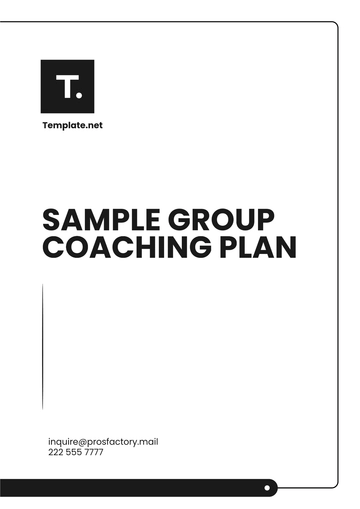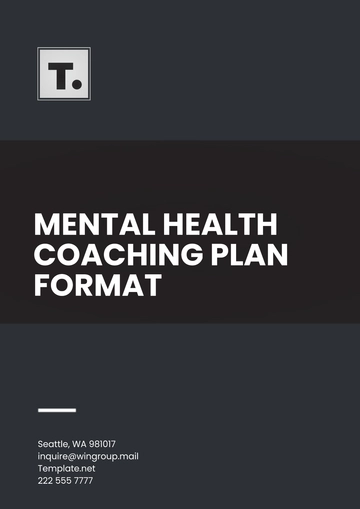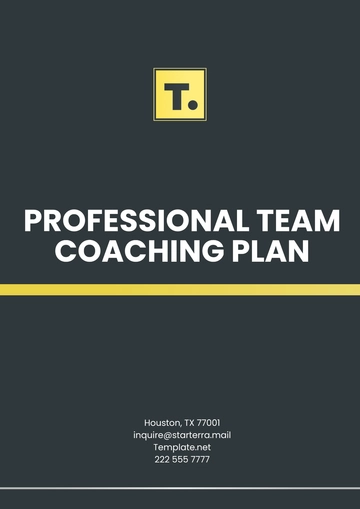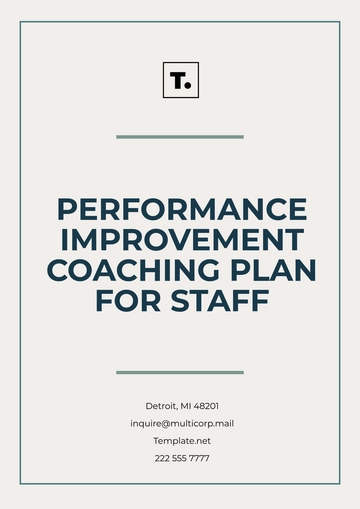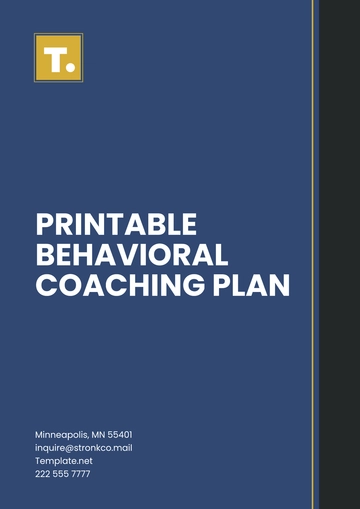Free Time Management Coaching Plan

Prepared by: [Your Name]
Date: [Date]
I. Introduction
This Time Management Coaching Plan is a comprehensive guide designed to help individuals optimize their productivity by developing effective time management strategies. It is aimed at professionals, students, or anyone who wishes to better organize their time to achieve both short-term and long-term goals. This plan will provide practical tools and techniques to help individuals create a balanced and productive schedule, reduce stress, and meet deadlines without feeling overwhelmed.
The plan focuses on understanding personal time management challenges, setting clear objectives, and implementing structured methods to maximize output and improve overall life satisfaction.
II. Assessment
A. Current Time Management Habits
The first step in this process is to assess how time is currently being spent. Keeping a time log for one week is recommended, noting down all activities including work, leisure, socializing, and personal tasks. By tracking time, individuals can identify areas where time is being wasted or spent inefficiently.
Example Log Entry:
8:00 AM - 9:00 AM: Checking emails (45 minutes)
9:00 AM - 10:00 AM: Work on Project A (1 hour)
10:00 AM - 10:15 AM: Social media break (15 minutes)
10:15 AM - 12:00 PM: Continue work on Project A (1 hour 45 minutes)
Common inefficiencies could include excessive time on social media, constant multitasking, or unclear task prioritization. Recognizing these patterns will help pinpoint areas for improvement.
B. Individual Strengths and Weaknesses
It’s essential to understand your strengths and weaknesses when it comes to managing time. Individuals may already have strengths like punctuality or the ability to work under pressure. These strengths should be acknowledged and leveraged throughout the coaching process.
Example Strengths:
Strong focus during uninterrupted work periods
Ability to prioritize tasks based on urgency
Example Weaknesses:
Difficulty saying no to additional tasks
Tendency to overcommit and become overwhelmed
By identifying these, the plan can be adjusted to capitalize on strengths and target areas for improvement.
III. Goals
A. Short-Term Goals
Short-term goals focus on immediate improvements and serve as stepping stones toward long-term success. These goals should be specific, measurable, attainable, relevant, and time-bound (SMART).
Example Goals:
Organize Daily Tasks: At the start of each day, identify the three most important tasks (MITs) to focus on.
Improve Work-Life Balance: Set clear boundaries for work hours and personal time. Avoid answering emails or taking work calls during non-work hours.
Short-term goals help build momentum and create a sense of accomplishment that boosts motivation.
B. Long-Term Goals
Long-term goals are broader and relate to overarching achievements in both personal and professional life. These goals help individuals maintain a clear sense of purpose and direction.
Example Goals:
Increase Productivity: Reduce time spent on low-priority tasks by 25% over the next 6 months.
Create a Sustainable Routine: Develop a balanced schedule that allows time for career, family, health, and personal interests, ensuring ongoing productivity without burnout.
These long-term objectives help guide overall time management efforts and keep focus on continual improvement.
IV. Strategies and Tools
A. Prioritization Methods
Effective time management relies heavily on prioritization. The following methods help ensure that time is spent on what matters most.
Eisenhower Matrix: This method categorizes tasks into four quadrants:
Urgent and Important: Do immediately (e.g., meeting a deadline).
Important but Not Urgent: Schedule these tasks (e.g., strategic planning).
Urgent but Not Important: Delegate where possible (e.g., answering non-critical emails).
Neither Urgent nor Important: Eliminate or minimize these tasks (e.g., mindless internet browsing).
Pareto Principle (80/20 Rule): This rule states that 80% of your results come from 20% of your efforts. Identifying the tasks that contribute most to your success and prioritizing them helps maximize efficiency.
B. Scheduling Tools
A key strategy in time management is organizing time effectively using the right tools.
Google Calendar or Microsoft Outlook: These digital tools allow you to schedule tasks, set reminders, and share calendars with colleagues or clients. You can block time for deep work and include buffer periods for unexpected tasks.
Trello or Asana: These task management tools help visually organize projects, track progress, and collaborate with others.
Notion: A versatile platform to create custom time management systems, from daily planners to long-term project timelines.
By using these tools, you can have a structured approach to your day and reduce the mental load of managing your tasks manually.
C. Productivity Techniques
Time management is not just about organizing tasks, but also about staying focused. Implementing productivity techniques can help individuals work more efficiently.
Pomodoro Technique: This involves working for 25-minute intervals followed by a 5-minute break. After four intervals, take a longer 15-30 minute break. This method increases focus and helps maintain energy levels throughout the day.
Time Blocking: Allocate specific blocks of time to particular tasks. For example, block 9:00 AM - 11:00 AM for work on Project A and 11:00 AM - 12:00 PM for emails and calls.
By using these techniques, individuals can optimize the time they spend on tasks, ensuring they stay productive without experiencing burnout.
V. Action Plan
A. Daily Tasks
Each day should begin with identifying the top three tasks that need immediate attention. These tasks should be linked to your long-term goals to maintain focus on what matters most.
Example Task List for the Day:
Finalize the marketing report (high priority)
Respond to client emails (medium priority)
Complete training on a new software tool (low priority)
B. Planning
Every Sunday, set aside 30 minutes to plan the upcoming week. Review your priorities and ensure that they align with your short-term and long-term goals.
Example Weekly Planning Activities:
Review and adjust goals for the week
Schedule important meetings or appointments
Ensure adequate time for self-care, exercise, and personal activities
C. Accountability
Accountability partners can ensure you stay on track. Arrange weekly check-ins with a coach, mentor, or colleague to review your progress, discuss challenges, and adjust your strategy as needed.
VI. Timeline
A. Initial Phase (Weeks 1–2)
In the initial phase, focus on understanding your current time management habits and setting achievable goals. Begin with simple tasks such as using the Eisenhower Matrix for prioritizing daily activities and incorporating basic time-blocking techniques.
B. Implementation Phase (Weeks 3–6)
During this phase, start experimenting with advanced tools such as Trello or Pomodoro. Begin tracking progress against short-term goals and fine-tune strategies to better fit your work style and personal preferences.
C. Maintenance Phase (Weeks 7+)
In the long-term phase, continue refining your time management system. Review progress regularly, re-evaluate goals, and adjust strategies to ensure sustained productivity.
VII. Evaluation Metrics
A. Progress Indicators
To gauge success, monitor key metrics such as:
Reduction in procrastination time
Improvement in the completion of high-priority tasks
Enhanced work-life balance, with fewer work-related stressors
B. Feedback
Collect feedback from peers, supervisors, or family members to see if they’ve noticed improvements in your punctuality, task management, and overall productivity.
VIII. Follow-Up Plan
A. Ongoing Adjustments
As circumstances change, continue to assess your time management plan. If new challenges arise (e.g., a change in work responsibilities), adjust your plan to accommodate these shifts.
B. Continued Learning
Commit to continuous learning and growth by reading productivity books, attending workshops, or taking courses. Stay updated on the latest tools and methods to keep improving your time management skills.
- 100% Customizable, free editor
- Access 1 Million+ Templates, photo’s & graphics
- Download or share as a template
- Click and replace photos, graphics, text, backgrounds
- Resize, crop, AI write & more
- Access advanced editor
Master time management with the Time Management Coaching Plan Template from Template.net. This editable and customizable template is ideal for creating structured plans that help clients optimize their time. With the Ai Editor Tool, easily tailor the plan to address individual productivity challenges. Whether it's balancing tasks or setting goals, this template offers a straightforward framework to improve time management skills and maximize efficiency.
You may also like
- Finance Plan
- Construction Plan
- Sales Plan
- Development Plan
- Career Plan
- Budget Plan
- HR Plan
- Education Plan
- Transition Plan
- Work Plan
- Training Plan
- Communication Plan
- Operation Plan
- Health And Safety Plan
- Strategy Plan
- Professional Development Plan
- Advertising Plan
- Risk Management Plan
- Restaurant Plan
- School Plan
- Nursing Home Patient Care Plan
- Nursing Care Plan
- Plan Event
- Startup Plan
- Social Media Plan
- Staffing Plan
- Annual Plan
- Content Plan
- Payment Plan
- Implementation Plan
- Hotel Plan
- Workout Plan
- Accounting Plan
- Campaign Plan
- Essay Plan
- 30 60 90 Day Plan
- Research Plan
- Recruitment Plan
- 90 Day Plan
- Quarterly Plan
- Emergency Plan
- 5 Year Plan
- Gym Plan
- Personal Plan
- IT and Software Plan
- Treatment Plan
- Real Estate Plan
- Law Firm Plan
- Healthcare Plan
- Improvement Plan
- Media Plan
- 5 Year Business Plan
- Learning Plan
- Marketing Campaign Plan
- Travel Agency Plan
- Cleaning Services Plan
- Interior Design Plan
- Performance Plan
- PR Plan
- Birth Plan
- Life Plan
- SEO Plan
- Disaster Recovery Plan
- Continuity Plan
- Launch Plan
- Legal Plan
- Behavior Plan
- Performance Improvement Plan
- Salon Plan
- Security Plan
- Security Management Plan
- Employee Development Plan
- Quality Plan
- Service Improvement Plan
- Growth Plan
- Incident Response Plan
- Basketball Plan
- Emergency Action Plan
- Product Launch Plan
- Spa Plan
- Employee Training Plan
- Data Analysis Plan
- Employee Action Plan
- Territory Plan
- Audit Plan
- Classroom Plan
- Activity Plan
- Parenting Plan
- Care Plan
- Project Execution Plan
- Exercise Plan
- Internship Plan
- Software Development Plan
- Continuous Improvement Plan
- Leave Plan
- 90 Day Sales Plan
- Advertising Agency Plan
- Employee Transition Plan
- Smart Action Plan
- Workplace Safety Plan
- Behavior Change Plan
- Contingency Plan
- Continuity of Operations Plan
- Health Plan
- Quality Control Plan
- Self Plan
- Sports Development Plan
- Change Management Plan
- Ecommerce Plan
- Personal Financial Plan
- Process Improvement Plan
- 30-60-90 Day Sales Plan
- Crisis Management Plan
- Engagement Plan
- Execution Plan
- Pandemic Plan
- Quality Assurance Plan
- Service Continuity Plan
- Agile Project Plan
- Fundraising Plan
- Job Transition Plan
- Asset Maintenance Plan
- Maintenance Plan
- Software Test Plan
- Staff Training and Development Plan
- 3 Year Plan
- Brand Activation Plan
- Release Plan
- Resource Plan
- Risk Mitigation Plan
- Teacher Plan
- 30 60 90 Day Plan for New Manager
- Food Safety Plan
- Food Truck Plan
- Hiring Plan
- Quality Management Plan
- Wellness Plan
- Behavior Intervention Plan
- Bonus Plan
- Investment Plan
- Maternity Leave Plan
- Pandemic Response Plan
- Succession Planning
- Coaching Plan
- Configuration Management Plan
- Remote Work Plan
- Self Care Plan
- Teaching Plan
- 100-Day Plan
- HACCP Plan
- Student Plan
- Sustainability Plan
- 30 60 90 Day Plan for Interview
- Access Plan
- Site Specific Safety Plan


